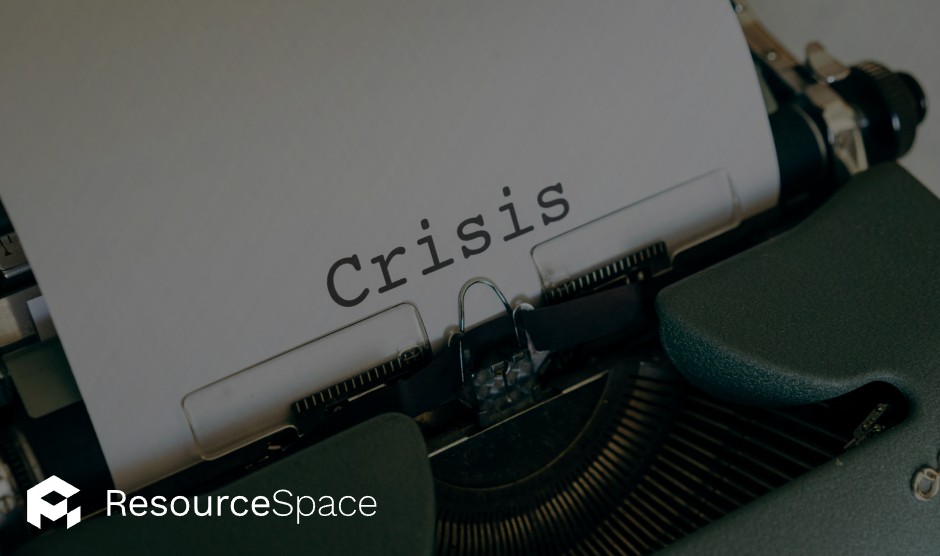
ResourceSpace has changed the way the DEC uses content, making it much easier for us to quickly make assets available both internally and externally during our emergency appeals.
Blog
18th February 2025

What’s the most important thing when it comes to generating new customers for your business? Product quality, customer service, value for money, positive reviews?
The answer is probably a combination of all of those factors and more, but it’s important to understand the value of a strong brand. While less tangible, your brand has the power to generate new business and drive sustained customer loyalty… as well as destroy your hard-earned reputation.
Brand crisis management refers to the strategies and actions taken by a company to protect its brand reputation from a negative event. This process prepares managers and employees to appropriately handle and remedy these situations, reduce the impact of the initial event, respond effectively and minimise the risk of making the issue worse.
A brand crisis can have various causes, such as negative publicity, product failures, data breaches, or controversial actions or public opinions given by employees or partners. These incidents can quickly damage public perception of a brand and erode customer trust, as well as impact a business’ short and long term financial performance.
A well-prepared crisis management plan can help businesses anticipate potential issues and outline clear steps to mitigate their impact.
The goal of brand crisis management is not just to resolve the immediate issue, but also to rebuild trust and demonstrate accountability. By taking responsibility, showing empathy and learning from the experience, businesses can emerge stronger and more resilient.
On the other hand, poorly thought out crisis management risks alienating consumers further, or irrevocably damaging brand trust.
READ MORE: Is your DAM on-brand?
Some of the world’s biggest brands have experienced brand crises, but here are two examples of companies that responded swiftly and appropriately to mitigate the negative impact.
What happened?
As a result of severe winter storms in December 2023, holiday provider JetBlue was forced to cancel a significant number of flights, while other holidaymakers faced big delays.
With people hoping to travel back home for the Christmas holidays this threatened to be a brand crisis for JetBlue.
The response
The key to handling this crisis effectively was communication, and JetBlue jumped into action across multiple channels to keep customers informed with real-time information.
The company also set up a dedicated team to support customers, handle their enquiries and help with booking alternative transport, as well as providing compensation where appropriate, including travel vouchers and even full refunds. The JetBlue CEO also issued an unequivocal public apology for the inconvenience the problems had caused.
This is an excellent example of a brand responding to a crisis with transparency and authenticity, and genuinely resolving issues for their customers.
What happened?
The Johnson & Johnson Tylenol crisis wasn’t just a brand crisis—it was a public health emergency.
In 1982, seven people died in Chicago after taking Tylenol—an over the counter medication available in the US—that had been laced with cyanide.
The response
Although it was believed to be an issue with products at a single store and not the manufacturing or packaging process, the company still acted decisively, halting all product advertising and sending a huge number of communications to healthcare facilities and issuing warnings to consumers. The company also developed tamper-proof packaging as a result of the crisis.
This was a great example of a brand going above and beyond to deal with a crisis. Johnson & Johnson could’ve let the store take the blame and insist their products were safe, but instead they tackled it head on to ensure they maintained consumer trust in their products.
Effective brand crisis management involves identifying the problem, responding swiftly and communicating transparently with stakeholders.
Let’s take a closer look at three steps for effective crisis management.
The first step is to identify who will be primarily responsible for identifying and dealing with brand crises. This should include stakeholders from departments across the organisation, and each member of the team should have clearly defined roles and responsibilities. If a brand crisis emerges you need to be able to deal with it quickly, and this will be impossible if people don’t understand how they’re supposed to respond.
However, although you’ll have appointed a dedicated team to deal with crises, you should educate every employee to understand the importance of recognising them at an early stage, and who they need to contact in order to initiate a response.
Your crisis management team should carry out a thorough risk assessment to highlight areas where your organisation might be vulnerable. This should include everything from product development and the supply chain, through to operational processes and customer service policies. Is the company receiving regular negative feedback about a particular issue? Have internal quality assessments highlighted potential problems that haven’t been acted on?
By understanding where the biggest risks are you can prioritise your crisis management efforts and dedicate resources to the issues that need attention.
How will you communicate with internal and external stakeholders should a crisis arise? Develop a communication plan that outlines how information will be shared inside and outside of the organisation, and who will be responsible for sharing it.
You’ve assembled the management team, developed a response plan and understand how you’ll communicate with stakeholders, but don’t wait for the first real-world crisis to find out if it’s going to be effective.
Just like you do with your company’s fire safety procedure, carry out drills to find out how it will work when put to the test. This will help you to identify gaps in the process and give the team experience and confidence for executing on their responsibilities when the stakes aren’t so high.
Following these drills make sure you review the results and identify what worked well and what didn’t so you can make improvements where necessary. This documentation and review stage is also important to do if the team ever has to respond to a real crisis.
READ MORE: DAM vs BAM: What's the difference between Digital and Brand Asset Management?
The examples of brand crises we looked at above might have all involved household names, but that doesn’t mean small and medium sized businesses can’t be significantly impacted too. It might not make headline news, but if your reputation within your industry suffers it’s going to lose you customers and put the financial health of the company at risk.
An effective crisis management strategy, supported by a dedicated team, can reduce the likelihood of this happening, and also mitigate the consequences in the event of a brand crisis occurring.
#CustomerTrust
#BrandLoyalty
#IndustryNews
#BestPractice
#ResourceSpaceTips
#BrandStrategy
#CustomerService
#ProductUpdates